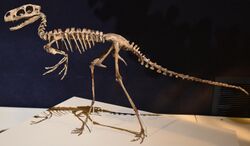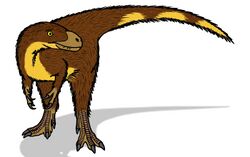Biology:Dilong paradoxus
| Dilong paradoxus | |
|---|---|

| |
| Skeleton cast mount at Milwaukee Public Museum | |
| Scientific classification | |
| Domain: | Eukaryota |
| Kingdom: | Animalia |
| Phylum: | Chordata |
| Clade: | Dinosauria |
| Clade: | Saurischia |
| Clade: | Theropoda |
| Clade: | †Pantyrannosauria |
| Genus: | †Dilong Xu et al., 2004 |
| Species: | †D. paradoxus
|
| Binomial name | |
| †Dilong paradoxus Xu et al., 2004
| |
Dilong (帝龍, which means 'emperor dragon') is a genus of basal tyrannosauroid dinosaur.[1] The only species in this genus is Dilong paradoxus. It is from the Lower Cretaceous Yixian Formation near Lujiatun, Beipiao, in the western Liaoning province of China . It lived about 126 million years ago.[2] This theropod discovery was significant as it was one of the first tyrannosauroids with fossil evidence of simple feathers.[3]
Discovery
Dilong was described by Xu Xing and colleagues in 2004.[3] The name is derived from the Chinese 帝 dì meaning 'emperor' and 龙 / 龍 lóng meaning 'dragon'. "Di", "emperor", refers to the relationship of this animal to Tyrannosaurus rex, the "king" tyrannosaurid. "Long" is used to name Chinese dinosaurs in much the same way that the ancient Greek -saur is in the West. The specific name, paradoxus, is a Latinisation of the Ancient Greek παράδοξον meaning 'against received wisdom'.
Description
The type specimen is IVPP 14243 (Institute of Vertebrate Paleontology and Paleoanthropology in Beijing), a nearly complete, semi-articulated, skull and skeleton. Referred material includes IVPP 1242, a nearly complete skull and presacral vertebrae, TNP01109 (Tianjin Museum of Natural History), a partial skull, and IVPP V11579, another skull which may belong to D. paradoxus, or to a related species.[3] The type specimen of Dilong was about 1.6 m (5.2 ft) in length, but it is thought to be a juvenile and may have been over 2 m (6.6 ft) long when fully grown.[4] Gregory S. Paul estimated that a 1.3 m (4.3 ft) long individual would have weighed 6 kg (13 lb).[5]
Feathers
Dilong paradoxus had a covering of simple feathers or protofeathers. The feathers were seen in fossilized skin impressions from near the jaw and tail. They are not identical to modern bird feathers, lacking a central shaft and most likely used for warmth, since they could not have enabled flight. Adult tyrannosaurs, found in Alberta and Mongolia have skin impressions which appear to show the pebbly scales typical of other dinosaurs. Xu et al. (2004) speculated that the tyrannosauroids may have had different skin coverings on different parts of their bodies—perhaps mixing scales and feathers. They also speculated that feathers may correlate negatively with body size—that juveniles may have been feathered, then shed the feathers and expressed only scales as the animal became larger and no longer needed insulation to stay warm.[3]
Classification
When Dilong was first described, it was considered one of the earliest and most primitive members of Tyrannosauroidea, the group that includes the later, larger tyrannosaurids such as Tyrannosaurus rex. At least one later study, by Turner and colleagues in 2007, reanalyzed the relationships of coelurosaurian dinosaurs, including Dilong, and found that it was not a tyrannosauroid. Rather, they placed Dilong two steps above the tyrannosauroids in their phylogeny; more advanced than Coelurus, but more primitive than the Compsognathidae.[6] However, other studies continued to find Dilong as a tyrannosauroid, and some (such as Carr & Williamson 2010) found Dilong to fall within Tyrannosauroidea, not among the more advanced coelurosaurs.[7]
Below is a cladogram containing most tyrannosauroids by Loewen et al. in 2013.[8]
| Tyrannosauroidea |
| |||||||||||||||||||||||||||||||||||||||||||||||||||||||||||||||||||||||||||||||||||||||||||||
In a 2014 study, Dilong was found to be a proceratosaurid.[1] However, in an analysis by Brusatte et al. in 2016, both parsimony and Bayesian phylogenetic analyses placed Dilong outside of Proceratosauridae, as a slightly more advanced tyrannosauroid.[9]
Paleobiology
Braincase scans indicate that Dilong had an S-shaped brain protected by thin meninges, unlike Tyrannosaurus which has a more linear brain protected by thicker meninges; this is probably a size-related trait, as it is in crocodilians. The large flocculus of Dilong suggests it was agile and had good balance, while small olfactory tracts suggest that its sense of smell was not as refined as that of Tyrannosaurus and other more advanced tyrannosauroids.[10]
See also
References
- ↑ 1.0 1.1 Juan D. Porfiri; Fernando E. Novas; Jorge O. Calvo; Federico L. Agnolín; Martín D. Ezcurra; Ignacio A. Cerda (2014). "Juvenile specimen of Megaraptor (Dinosauria, Theropoda) sheds light about tyrannosauroid radiation". Cretaceous Research 51: 35–55. doi:10.1016/j.cretres.2014.04.007.
- ↑ Chang, S.-C.; Gao, K.-Q.; Zhou, Z.-F.; Jourdan, F. (2017). "New chronostratigraphic constraints on the Yixian Formation with implications for the Jehol Biota". Palaeogeography, Palaeoclimatology, Palaeoecology 487: 399–406. doi:10.1016/j.palaeo.2017.09.026. Bibcode: 2017PPP...487..399C.
- ↑ 3.0 3.1 3.2 3.3 Xu, X.; Norell, M. A.; Kuang, X.; Wang, X.; Zhao, Q.; Jia, C. (2004). "Basal tyrannosauroids from China and evidence for protofeathers in tyrannosauroids". Nature 431 (7009): 680–684. doi:10.1038/nature02855. PMID 15470426. Bibcode: 2004Natur.431..680X. http://www.geo.arizona.edu/geo3xx/geo308/FoldersOnServer/2004/nature02855.pdf. Retrieved 2011-05-11.
- ↑ Shih, C.; Gao, T.; Ren, D. (2019). "Coexisting Animals and Plants in the Ecosystems". Rhythms of Insect Evolution: Evidence from the Jurassic and Cretaceous in Northern China. Wiley-Blackwell. pp. 17–30. doi:10.1002/9781119427957.ch2. ISBN 9781119427957.
- ↑ Paul, Gregory S. (2016). The Princeton Field Guide to Dinosaurs. Princeton University Press. pp. 106. ISBN 978-1-78684-190-2. OCLC 985402380. http://worldcat.org/oclc/985402380.
- ↑ Turner, A.H., Pol, D., Clarke, J.A., Erickson, G.M., and Norell, M. (2007). "Supporting online material for: A basal dromaeosaurid and size evolution preceding avian flight". Science, 317: 1378-1381. doi:10.1126/science.1144066 (supplement)
- ↑ Carr T.D.; Williamson T.E. (2010). "Bistahieversor sealeyi, gen. et sp. nov., a new tyrannosauroid from New Mexico and the origin of deep snouts in Tyrannosauroidea". Journal of Vertebrate Paleontology 30 (1): 1–16. doi:10.1080/02724630903413032.
- ↑ Loewen, M.A.; Irmis, R.B.; Sertich, J.J.W.; Currie, P. J.; Sampson, S. D. (2013). Evans, David C. ed. "Tyrant Dinosaur Evolution Tracks the Rise and Fall of Late Cretaceous Oceans". PLoS ONE 8 (11): e79420. doi:10.1371/journal.pone.0079420. PMID 24223179. Bibcode: 2013PLoSO...879420L.
- ↑ Brusatte, Stephen L.; Carr, Thomas D. (2016-02-02). "The phylogeny and evolutionary history of tyrannosauroid dinosaurs" (in en). Scientific Reports 6 (1): 20252. doi:10.1038/srep20252. ISSN 2045-2322. PMID 26830019. Bibcode: 2016NatSR...620252B.
- ↑ Kundrát, Martin; Xu, Xing; Hančová, Martina; Gajdoš, Andrej; Guo, Yu; Chen, Defeng (2018). "Evolutionary disparity in the endoneurocranial configuration between small and gigantic tyrannosauroids". Historical Biology 32 (5): 1–15. doi:10.1080/08912963.2018.1518442.
External links
Wikidata ☰ Q27439 entry
 |






